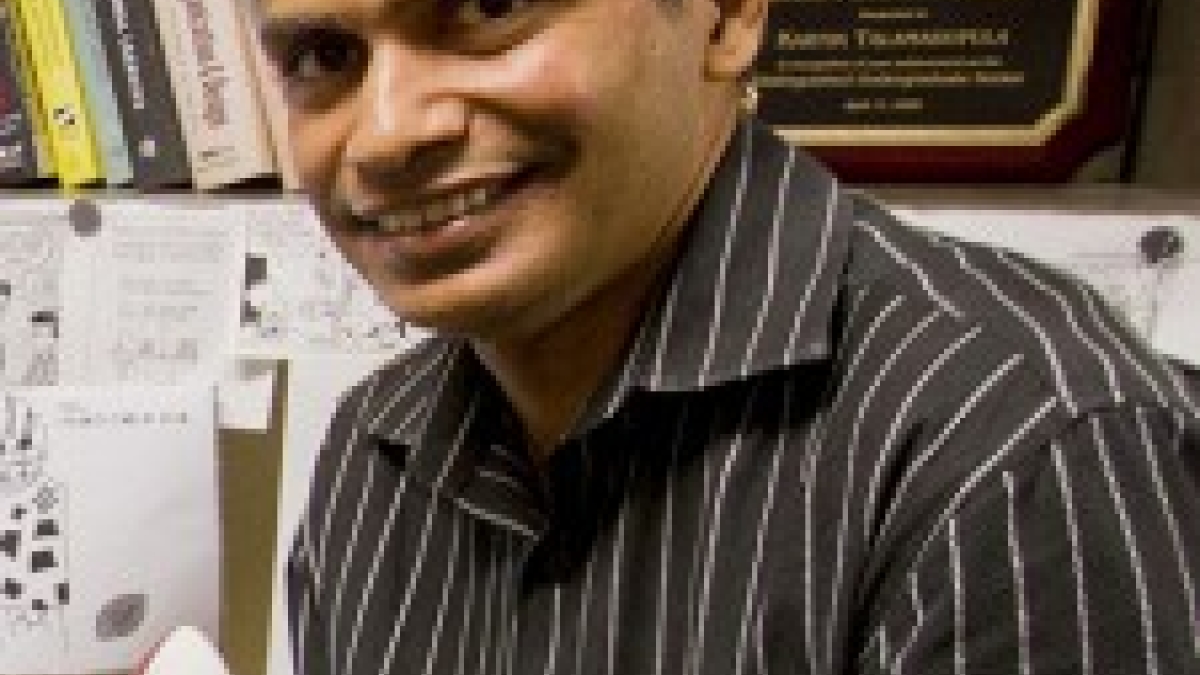ASU professors win funding to further national defense research

Three professors in the Ira A. Fulton Schools of Engineering at Arizona State University have been selected for awards through the 2014 Defense University Research Instrumentation Program.
The program provides funding for major equipment necessary for ongoing or new research relevant to the U.S. Department of Defense.
Subbarao Kambhampati, a professor of computer engineering, received about $150,000; Yong-Hang Zhang, a professor of electrical engineering and associate dean for research, received about $135,00; and Dijiang Huang, an associate professor of computer science received nearly $100,000.
Subbarao Kambhampati
School of Computing, Informatics and Decision Systems Engineering
Kambhampati, whose research is focused on robots and humans working cooperatively on problem-solving, will use the funds for new robots.
ASU currently has several NAObots, which are autonomous, programmable humanoid robots. Six of them are used on ASU’s robot soccer team, and one in Kambhampati’s lab. Kambhampati plans to purchase two or three new humanoid robots, including an unbounded robot, the latest technology.
The new robots will use wheels, rather than feet, moving more quickly and making demonstrations more engaging. In addition, the unbounded robot has an advanced, intricate arm that more closely mimics a human arm and its multiple number of degree movements.
“It allows more freedom in grasping and lifting,” Kambhampati said.
The robots will help with research Kambhampati is doing with support from grants – two from the U.S. Office of Naval Research and one from the U.S. Army Research Office.
One example of cooperative problem-solving between humans and robots would be a search-and-rescue mission in which a human commander, in a remote, safe location, has wireless communication with a robot in a damaged building. The commander could give the robot goals, such as, “Look for injured people in this room,” or “Rendezvous in the corridor at this time.”
The robot, which would have access to domain models, including actions and preconditions, would have to use automated planning techniques to figure out what steps to take. It requires the robots to intelligently analyze the situation, moment to moment.
For example, in the search-and-rescue mission, the state of the building may be different from that shown in the map because walls may have collapsed and corridors may be blocked. Goals may come piecemeal or change based on the fluid situation, and the robot must decide which to prioritize.
Yong-Hang Zhang
School of Electrical, Computer and Energy Engineering
Zhang said his funding will be used to build more sophisticated and user-friendly materials and device-testing systems for infrared detector research, which is also supported by a Department of Defense Multidisciplinary University Research Initiative grant, and has defense and commercial application, such as night vision, security monitoring systems and biomedical imaging.
“If you are driving at night, infrared can help you see better,” Zhang said. “For example, if a deer is coming out of the woods, headlights don’t project well, and this can be a very dangerous situation.
“Infrared also would be useful during a dust storm or in fog.”
The new equipment would include a state-of-the-art setup for testing detectors at various temperatures, from room temperature to very low (minus 270 degrees Celsius), and an upgraded optical spectroscopy, which measures the optical spectrum from materials or light-emitting devices.
“Right now, if you want to take a spectrum, it takes 15 to 20 minutes,” Zhang said. “Our research requires us to take hundreds, so it can take forever.
“With the new equipment, we will be able to take one in less than 10 seconds, almost like a camera, so taking 200 spectra is not a big deal and can be done in a day.”
The equipment will give ASU unique capability, Zhang said, improving efficiency and raising the visibility of current and future research.
Dijiang Huang
School of Computing, Informatics and Decision Systems Engineering
Huang said his funding will be used to purchase communication devices, servers and a spectrum analyzer to create the Open Human-Robotic Mobile Networking and Security Testbed, a secure mobile network to interact with robots.
Huang said that researchers and students are more frequently using mobile applications to communicate with robots, and security is becoming even more important.
The equipment will support Huang’s ongoing research project, Traffic Analysis Models for Wireless Mobile Ad Hoc Networks, which establishes a user-friendly open MANET (mobile ad-hoc network) system for research and education.
“In the battlefield environment, soldiers need to establish ad-hoc networks with different requirements that could be changed based on mission goals,” Huang said. “Security protocols could protect soldier’s lives.”
And the networks could enhance civilian life, too.
“What we see in our next five to 10 years is more interaction between the physical world and our virtual life through web-based services,” Huang said. “Our mobile devices will be more intelligent and have more situational awareness. They will be able to sense where we are and whether something is happening there that we might be interested in, or provide help if we’re missing something.”
Huang said that as we have more of these virtual and physical life interactions, we must have secure, private applications.
“If our private data isn’t protected, people won’t be able to use these applications and devices. It’s a very critical issue.”